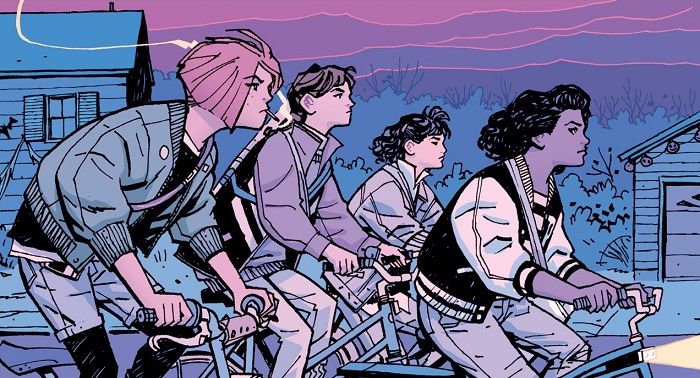I think it’s safe to say that 2015 was the year of Image Comics. Their titles and creators topped just about every Best of Comics list—including both of mine—and for good reason. By letting the creators run the show, they are free from the constraints of mass appeal and densely tangled histories and origin stories run rampant in DC and Marvel. Not that the Big Two haven’t made some bold choices this year, but no matter what they do they are always stuck playing catch up. Where Image takes three giant leaps ahead, DC and Marvel take two small steps forward then trip over their blind pandering and fall back a step. To reward Image for its forethought and quality, I think it only fair to devote the first Pull List of 2016 to two of its best series to debut last year: Paper Girls and Plutona.
Origin Stories
Paper Girls
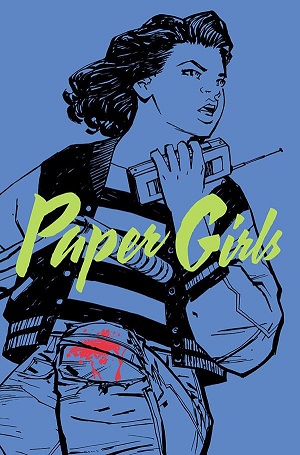 Just before dawn the morning after Halloween of 1988, 12-year-old Erin starts her newspaper delivery route in her residential neighborhood in Cleveland. She joins up with three other girls—Mac, Tiffany, and K.J.—and fights off a pack of criminally-inclined teenagers, but they are the least of their troubles. As their neighbors and family members begin vanishing right before their eyes, the girls get caught between two opposing factions of mysterious and murderous human-like creatures. They may be aliens from an alternate timeline, or something else even worse, but the one thing that is obvious is that if the girls aren’t careful they’ll end up either dead or disappeared. Everyone’s calling this Stand by Me by way of War of the Worlds (and I’d probably add in a splash of Attack the Block and Super 8 as well), and they’re not wrong. Like Plutona, this is a series about kids but not for them.
Just before dawn the morning after Halloween of 1988, 12-year-old Erin starts her newspaper delivery route in her residential neighborhood in Cleveland. She joins up with three other girls—Mac, Tiffany, and K.J.—and fights off a pack of criminally-inclined teenagers, but they are the least of their troubles. As their neighbors and family members begin vanishing right before their eyes, the girls get caught between two opposing factions of mysterious and murderous human-like creatures. They may be aliens from an alternate timeline, or something else even worse, but the one thing that is obvious is that if the girls aren’t careful they’ll end up either dead or disappeared. Everyone’s calling this Stand by Me by way of War of the Worlds (and I’d probably add in a splash of Attack the Block and Super 8 as well), and they’re not wrong. Like Plutona, this is a series about kids but not for them.
Paper Girls is an Image series, with three issues out so far; #4 releases this month. Creators Brian K. Vaughan and Cliff Chiang handle the writing and interior artwork/covers, respectively, and are assisted by colorist Matt Wilson and letterer Jared K. Fletcher.
Plutona
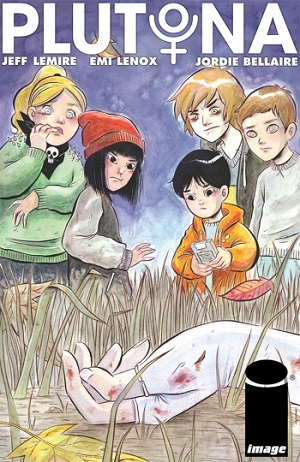 Speaking of plucky, trouble-making kids trapped between battling forces they are wildly unprepared for, Plutona’s world is permeated by superheroes rather than invaded by aliens. A group of preteens stumble upon the dead eponymous superhero, her broken, bloody body abandoned in the woods. Things get even more worrisome when they head back to the dump site to bury her and find her body already gone. Meanwhile two of the kids go behind their friends’ backs and make a dangerous attempt to turn themselves into superhumans. The last few pages of each issue offer flashbacks of Plutona’s last few hours from the perspectives of her and her daughter. There’s a bigger story going on in the background about a war between superheroes and supervillains, and these five kids have unwittingly wandering in from the periphery.
Speaking of plucky, trouble-making kids trapped between battling forces they are wildly unprepared for, Plutona’s world is permeated by superheroes rather than invaded by aliens. A group of preteens stumble upon the dead eponymous superhero, her broken, bloody body abandoned in the woods. Things get even more worrisome when they head back to the dump site to bury her and find her body already gone. Meanwhile two of the kids go behind their friends’ backs and make a dangerous attempt to turn themselves into superhumans. The last few pages of each issue offer flashbacks of Plutona’s last few hours from the perspectives of her and her daughter. There’s a bigger story going on in the background about a war between superheroes and supervillains, and these five kids have unwittingly wandering in from the periphery.
Emi Lenox and Jeff Lemire created the story of Plutona, with the former as the series and cover artist and the latter as the writer, as well as artist for the flashback featurettes at the back of the issues. Jordie Bellaire is the colorist and Steve Wands letterer. It is also published by Image. The third issue is out now, but the fourth and fifth won’t release until February 2016.
To Pull or Not To Pull
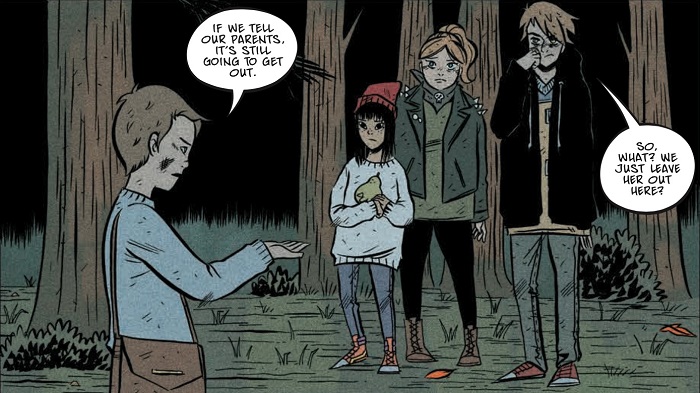
From the moment Paper Girls was announced way back in the January 2015 Image Expo, I have waited with bated breath. It’s first issue more than lived up to the hype, and subsequent releases have only raised the bar. Like Plutona, Paper Girls hints at a larger story unfolding around the kids, but Vaughan and Chiang keep the focus tight and the tension taut. We only see bits and pieces of the bigger story and the girls are only really interested in their immediate surroundings, but there are enough clues scattered about to get a feel for the context even if we have no idea what it all means. Items appear out of time—dinosaurs, an iPad, cellphones at different stages of evolution, cyborgs who speak with Shakespearean inflections—disorienting the reader as much as the girls, yet while their world grows larger it still feels centered on them.
The story is personal and heartfelt, a coming-of-age tale not about young love or schoolyard adventures but chaos and tragedy and loneliness and fear. After just one issue I felt like I had known these girls for years, and every turn of the screw leaves me anxious to find out what will happen to them next. The girls drive the story, not the aliens or whatever they are, although the mysterious creatures are the bomb that sets off the chain of events compelling the girls into action. They can’t fight back against what’s happening to them, but they can protect themselves and have enough teenage sense to know when to run and when to seek help. Troubled waters run deep with Mac, K.J., Erin, and Tiffany, and while the outside world roils in turmoil their inner lives are just as emotional.
Even the most novice comic book reader knows about Brian K. Vaughan, so there isn’t much more to add about how stellar his work is. He can craft a story like no other both in terms of creating unique worlds and writing realistic dialogue. I’d only known Cliff Chiang through his exquisite art on Brian Azzarello’s Wonder Woman arc a while back, and he’s gotten even better since. He favors clever closeups, unusual angles, and evocative microexpressions that bring a vibrant, vicious beauty to Vaughan’s script. Matt Wilson’s bright 80s-esque colors pair remarkably well with Chiang’s heavy, dark linework, making the whole thing a feel like a technicolor dream. Anyone who says font choice doesn’t matter needs to have a chat with letterer Jared K. Fletcher. Between the lively font, mixed-case text, and outline-free speech bubbles, I absolutely love the idiosyncrasy.
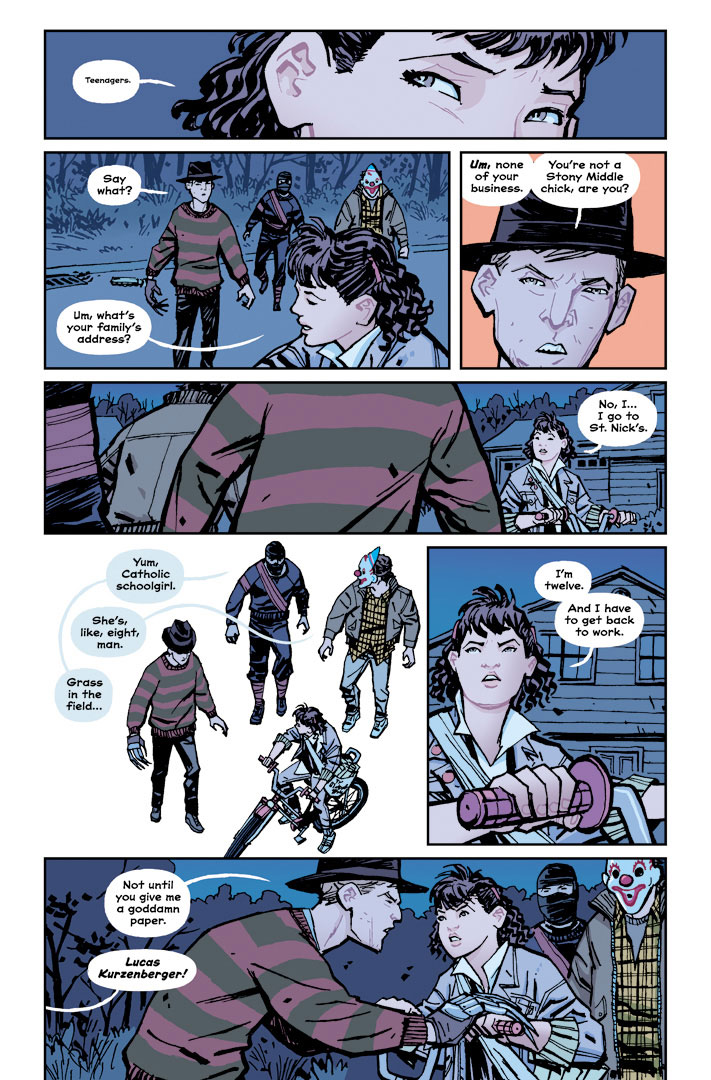
Jeff Lemire is one of those rare writers who can write kids and have them actually behave like kids. Mie flip-flops between being a tough kid who smokes and bullies her classmates to a confused little girl who feels bad when she hurts her friend’s feelings. That doesn’t make her contradictory, it makes her a kid still finding her place in the world and trying to decide what kind of person she wants to be. Ray acts out, but so do most kids desperate for attention they aren’t getting at home. Mike is young enough to let the older kids push him around because at least he gets to hang out with them. Di is a do-gooder and a fraidy-cat who’s probably braver than she realizes. Teddy is what happens when a child acquires an unhealthy obsession and no adult steps in to mediate it. I’ve seen kids just like these five before, and see a lot of myself in Mie when I was her age.
Although Plutona’s name graces the cover and her corpse thrusts the tweens onto their tumultuous path, Plutona isn’t really about her at all. The kids’ interest in superheroes extends only as far as they directly impact their lives; anything beyond what’s right in front of them is just background noise, and if you’ve ever spent time with kids you’ll recognize that myopia. This is their story, and Plutona is the incident that brings their personalities to the forefront. The larger story of superheroics will certainly come into play as time goes on, especially once her family and killer get wind of her corpse, but for now Lemire and Lenox are content to let the tale gradually unfold.
If you aren’t already familiar with Emi Lenox, Plutona is a great introduction. She has a light, playful style influenced by manga but grounded in American cartoons. Lenox does as much storytelling and character development as Lemire’s dialogue. Her panels are descriptive without being dense, giving colorist Jordie Bellaire enough space to fill in with muted yet vivid colors. In a way, the palette reminds me of the color scheme on an 80s movie on a worn VHS tape. Letterer Steve Wands matches Lemire as much as Bellaire does Lenox. He adds a vibrancy to Lemire’s text that wonderfully amplifies the story.
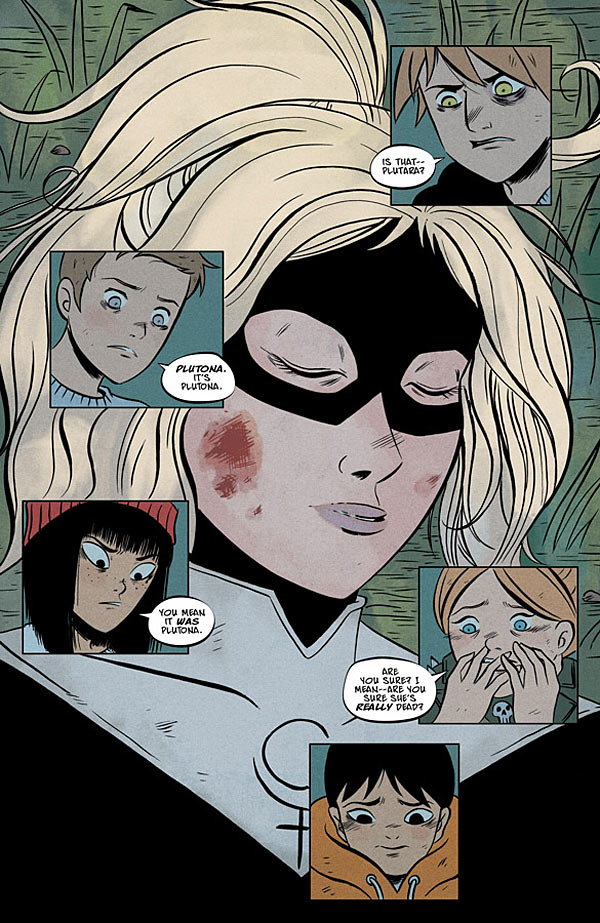
The only real negative of Paper Girls is on the production side. For a series all about girls it’d be nice to have some women on the creative team. Vaughan’s had a hand in crafting some of the best female comic book characters of the new millennium—hello there, Agent 355 and Alana—so it’s not like I’m worried about the girls’ characterizations. It’s more that Image is still as much of a white boys club as DC and Marvel and it’d be nice to see the creative side become as diverse as the content they produce. Plutona has no such issues. Half of the creative team are women, one of whom has Japanese ancestry.
There’s a reason I put Paper Girls down as my favorite new series of 2015. I’ve read a ton of amazing comics this year, but this was the one that grabbed me from the first issue and refuses to let go. The issues simply cannot come quickly enough. I look forward to one day having years of issues stacked on my bookshelves. Plutona doesn’t do quite enough to make its quintet as intriguing off the bat as the Vaughan quartet, but the worldbuilding is damn good. Lemire and Lenox throw the reader headfirst into a vast and complicated story of which we can only see a fraction. I want to know everything about these kids and what’s going to happen to them. Comic book readers looking for challenging and unique titles were spoiled for choices in 2015, and there’s no denying that Paper Girls and Plutona are at the top of the heap.
Alex Brown is an archivist, research librarian, writer, geeknerdloserweirdo, and all-around pop culture obsessive who watches entirely too much TV. Keep up with her every move on Twitter and Instagram, or get lost in the rabbit warren of ships and fandoms on her Tumblr.










